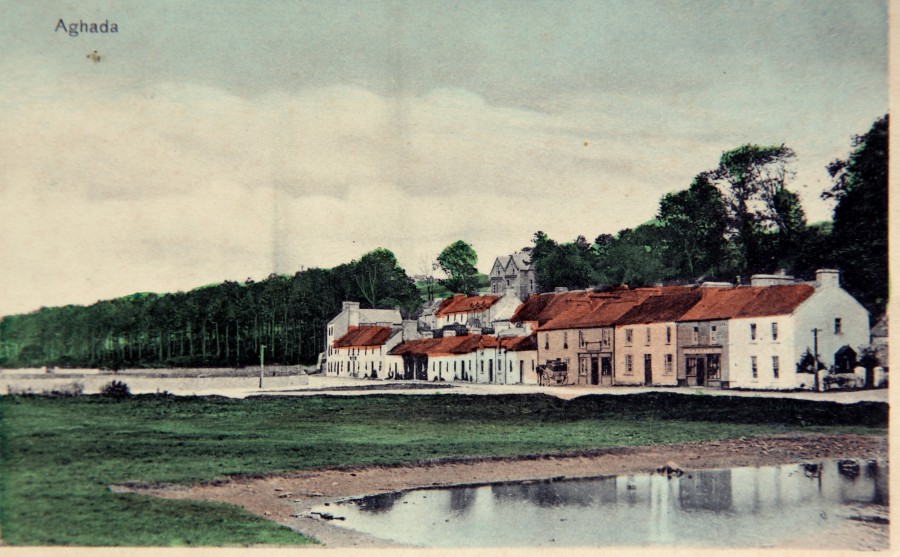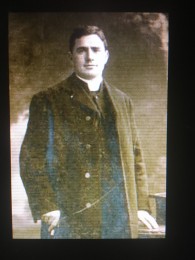
Kieran’s Our City, Our Town Article,
Cork Independent, 26 January 2017
The Wheels of 1917: Revival of the Gaelic League
One hundred years ago on Sunday 14 January 1917 the annual general meeting of the Gaelic League in Cork was held in the “Grianan”, 3 Queen Street, now Fr Mathew Street. Mr Tadhg Ó Tuama, a member of the Executive, presided. The Gaelic League offers another lens into exploring social life in Cork a century ago. In July 1893, Douglas Hyde was joint founder, with Eoin MacNeill, of the Gaelic League, which in Irish is Conradh na Gaeilge. Hyde was President of the organisation until he resigned in 1915. The purpose of the Gaelic League was to keep the Irish language alive and to preserve the Gaelic elements of Ireland’s culture. Although the Gaelic League was non-political, increasingly it became identified with these political goals, due to its membership. The Gaelic League grew dramatically in the early years of the twentieth century. Many Sinn Féin activists joined it with over 550 branches nationwide. Of the 16 leaders executed post the 1916 Rising, the majority were Gaelic League members and Irish speakers.
The Honorary Secretary Liam De Róiste. of the Executive read the annual report on 14 January 1917. Fifteen boxes of the Liam De Róiste Papers survive in the City and County Archive. An Irish language speaker and enthusiast, he was founder member in 1899, and in turn Secretary and Chairman, of the Cork branch of Conradh na Gaeilge (Gaelic League). He was a founder member of Coláiste na Mumhan in Ballingeary and founder member of the Cork Celtic Literary Society alongside figures such as Terence MacSwiney and Tomás MacCurtain, Seán O’Hegarty and Daniel Corkery. He was secretary of the Cork Industrial Development Association. He was Chairman/Vice Chairman of the Cork branch of Sinn Féin and chaired its first meeting, attended by Eoin MacNeill and Douglas Hyde, in 1906. De Róiste was a prominent early member of the Irish Volunteers movement, taking part in the 1916 Rising. He marched to Macroom on Easter Sunday 1916 and later helping to smuggle arms for the old IRA.
At the January 1917 meeting, Mr De Róiste detailed that the Gaelic League was re-organising nationally and there was a revival in Cork level following a difficult year of surviving scrutiny of its activities from Westminster. He noted that “the sympathy of the people was with the language movement” and this was shown by the substantial sums received during Irish Week and the flag day held in November 1916. There were four active city branches with a base at 3 Great George Street or now Oliver Plunkett Street. Branches as well existed in the principal towns and village in County Cork. Children’s classes for Irish had been established in the city and there were about 60 children in constant attendance with the average age was seven or eight years. The League was short teachers and suitable accommodation. He deemed the “teaching of the children. was real, solid, fruitful work, the results of which were visible before their eyes”.
During 1916, the Cork Branch had also established, a scholarship scheme, the object of which was to encourage the speaking of Irish among school children in city schools. Three young people-were sent for a month’s course to the Munster Training College, Ballingeary (est.1904), one from St Vincent’s Convent Schools, one from St. Marie’s of the Isle, and one from the North Monastery. They aspired to send at least ten school pupils every year to Irish-speaking districts.
Traditional singing class at the Cork School of Music under Fr Seamus (Christy) Ó Floinn. Ordained in 1909, Fr O’Flynn (1881-1962) had served as a priest at St Finbarr’s Seminary, Farranferris (1909 – 1913 and again in 1917) and was Chaplain to the Cork Lunatic Asylum. At thirty years of age in 1917, Fr O’Flynn was a strong voice of the Gaelic League in Cork appearing to give speeches across the City and County encouraging enrolment before 1917 and beyond. Before World War I he discovered his love of Irish in Balllingeary and was connected with the Gaelic League for many years. He worked with Fr Peadar Ó Laoghaire in the pioneering days of the language revival while he was still a student at the seminary at Maynooth. He had prevailed upon Fr Ó Laoghaire to write his famous small prayer book in Irish, which became one of the main textbooks for Irish learners in those days.
Fr O’Flynn’s personal contributions to local concerts and such functions always ensured their success. In various obituaries in 1962, Fr O’Flynn was detailed as a natural musician; he was one of the first to encourage Gregorian chant. Through his personal influence Irish composer and arranger of traditional music Dr Karl Hardebeck was brought to Cork in 1919 and made headmaster of the Cork School of Music as well as Professor of Irish music in UCC in 1922 (returning to Belfast after the Irish Civil War). Fr O’Flynn himself also gave regular assistance at UCC as a teacher at the Irish summer schools in the early days of the Gaelic revival. In a few short years (1924), he would establish a school of drama in a loft above Linehan’s Sweet Factory in the Shandon area of Cork City. He would also work with pupils with speech and language impairments.
If anyone has information on the former cultural centre An Grianán on Fr Mathew Street and its fate, give me a call, 087655389, thanks.
Cork 1916, A Year Examined (2016) by Kieran McCarthy & Suzanne Kirwan is now available in Cork bookshops.
Cork City History Tour (2016) by Kieran McCarthy is also available in Cork bookshops.
Captions:
879a. Fr O’Flynn in his twenties/ thirties (source: North Cathedral Archive)
879b. Site of An Grianán, the South Parish Branch of the Gaelic League, 3 Fr Mathew Street – also the former site of the Fr Mathew Abstinence Hall in Cork (picture: Kieran McCarthy)

Question to the CE:
To ask the CE for a progress report on archaeology monitoring at the event centre site? (Cllr Kieran McCarthy)
Motions:
Marian Park, Resurfacing:
That the Council review the deteriorating conditions of the parking area/footpaths fronting House No’s 11 to 20 at Marian Park. They have completely disintegrated over the Winter, pockmarked with potholes, and are giving rise to the risk of damage to vehicles and a trip hazard for residents in particular young children. The surface levels of the whole parking area needs to be reduced and resurfaced. Also the footpaths fronting these houses need to be replaced as they are now very uneven and at the same level as the parking area (Council Reference No. 21947 and 19198).
With reference to the works carried out by the City Council on the triangular piece of green area to the front of No’s 9 and 11 Marian Park where two strips of tarmac were laid, the Committee would request the City Council to also tarmac/pave the remaining piece of the green area as it is now a patch of mud which is a trip hazard and quite unsightly (Council Reference No. 19199).
There is also the issue of road/footpath subsidence outside Number 59 and 60 on Church Road. This may have been connected to the recent repair of a water main break, which was repaired very effectively and expeditiously by Council Staff. However, the road over the main has subsided due to the works leading to a series of ponds forming anytime it rains causing an inconvenience to pedestrians. We request the Council to raise the surface level and resurface the area (Council Reference No. 21950) (Cllr Kieran McCarthy).
Marina Trees:
For each of the trees that have been cut down on the Marina for different reasons, that they be replaced by younger trees (Cllr Kieran McCarthy).
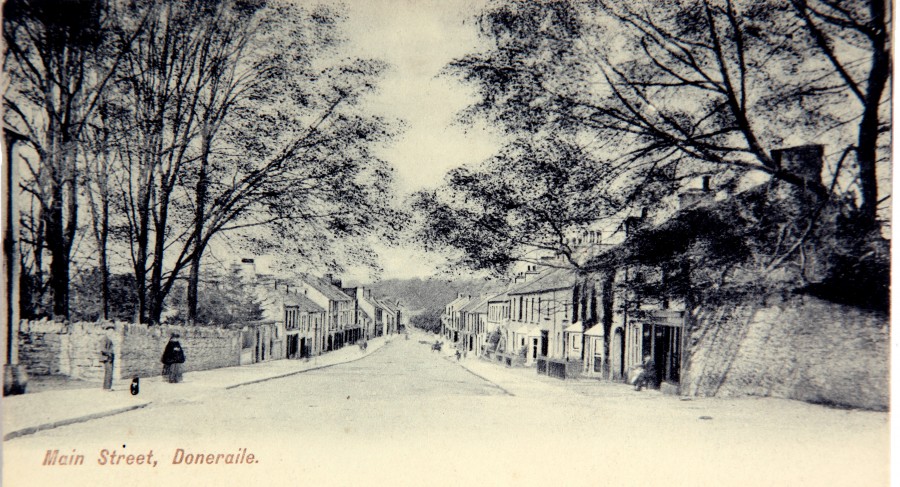
Kieran’s Our City, Our Town Article,
Cork Independent, 19 January 2017
The Wheels of 1917: Made in Cork
This week’s article is inspired by a summary report, 100 years ago today, in the Cork Examiner on 19 January 1917. The article addressed the activity levels of technical instruction in County Cork and the educational, arts and crafts activities associated with it for the season 1915-16. The article is also inspired by the current and great exhibition in the Crawford Art Gallery called Made in Cork, it celebrates the unique history of the arts and crafts movement in the County and city of Cork from the early twentieth century. The collection of 70 beautiful examples of the finest crafts Cork has to offer is curated by art historian Vera Ryan. The exhibition runs till 25 February 25 and commemorates both the centenary of the Honan Chapel, which was opened in 1916 and the centenary of the 1917 Arts and Crafts Society exhibition in Cork, which took place in the Crawford Art Gallery, then Cork School of Art.
The meeting of the County Cork Technical Committee was held on the third week of January 1917. It was a monthly meeting and was chaired by Canon Thomas Barrett, Parish Priest in Passage West. He had deeps interests in promoting community life and education and also had fundraised successfully monies for the construction of the Catholic Young Men’s Society Hall in Passage. The committee, Canon Barrett chaired, had been created some years previously, under the banner of the Agriculture and Technical Instruction (Ireland) Act in 1899. The act recognised the need for an Irish framework for technical education in an attempt to halt industrial and manufacturing decline and provide employment. Technical instruction was re-organised under local authorities and committees were funded to run local programmes. County Councils also had to rent schools, and in many instances had to also build them. A system of instruction outreach was planned in experimental science, drawing, and manual work, and domestic economy in day secondary schools.
At the January 1917 meeting a summary of Technical Instruction Inspector, Mr J J McCaffrey’s report was read out on the scheme of technical instruction in County Cork during the session 1915-16. He praised the work of the instructors but as per the national mantra in technical instruction he pressed to have them work longer hours. The committee was quick to note that it’s finances were at breaking point, was struggling to rent appropriate spaces for instruction and was finding it difficult to provide twenty hours of teaching for instructors in some of the outlier districts. The debate and results do offer an insight into the nature of arts and crafts in Cork and its geographic spread in 1917 and the underpinning of the importance of local industry to provide personal opportunity one hundred years ago.
During the winter session, the work of the eight manual instructors employed under the technical instruction scheme were organised in elements such as woodwork, domestic economy, embroidery, needlework, commercial work, and art classes. Classes were about to be arranged in farriery for blacksmiths and in rural science and school gardening for National school teachers. From late Spring the eight technical instructors were occupied five days weekly and taught on an average for eighteen hours a week. McCaffrey, the inspector, noted that the results from the classes in manual instruction work were excellent in the Charleville, Doneraile, Youghal and Passage West. Several tradesmen received instruction in carpentry and joinery in Kanturk, and there was a small day class for apprentices in Fermoy. A small first year building construction class was taught in Youghal. McCaffrey noted that instruction in Baltimore in manual instruction, practical geometry and several stages of boat-building drawing were taken concurrently with the students meeting in three different classrooms. Under such circumstances progress was not being made.
Syllabuses were followed in domestic economy, and in many of the centres the number of students enrolled was quite large. The classroom used at Killavullen was deemed by McCaffrey as satisfactorily lit, but stood in need of repairs, whilst that at Ballyhooly the room gave a very good floor space, but was also poorly lit. Courses in cookery were held in two permanent centres – Mallow and Youghal. The Mallow class suffered from oversubscription. The teaching of needlework was deemed satisfactory in many centres. At Macroom, instruction was given in various kinds of plain needlework. At Ballineen the accommodation was reported as quite unsuitable as seats were not provided. An instructress in crochet work conducted courses in temporary centres. McCaffrey highlights that the accommodation at Knockavilla was deemed satisfactory, but that at Crossbarry was unsuitable and that the work-room needed to be more comfortable.
The commercial courses were deemed well conducted at all centres from Bantry to Charleville. The accommodation provided though was deemed not suitable for commercial students. Art classes for teachers were satisfactorily conducted at Mallow and Bantry. Art classes for ordinary students were held in Fermoy. At Passage West, classes were held in three science subjects under part-time teachers. In each of these, parallel instruction was given in two or more syllabuses, much to the detriment of students who wished to attend all the classes. McCaffrey’s report offers an interesting light into arts and craft education in County Cork but check out Vera Ryan’s Exhibition, Made in Cork in the Crawford Art Galley to discover more on the production of some real treasured and local crafted work from circa 1917.
If you missed one of the columns in 2016 and before, check out the Our City, Our Town index at my website, www.corkheritage.ie
Cork 1916, A Year Examined (2016) by Kieran McCarthy & Suzanne Kirwan is now available in Cork bookshops.
Cork City History Tour (2016) by Kieran McCarthy is also available in Cork bookshops.
Captions:
878a. Main Street, Doneraile, c.1910 (source: North Cork Through Time by Kieran McCarthy & Dan Breen)
878b. New Street, Bantry, c.1910 (source: West Cork Through Time by Kieran McCarthy & Dan Breen)
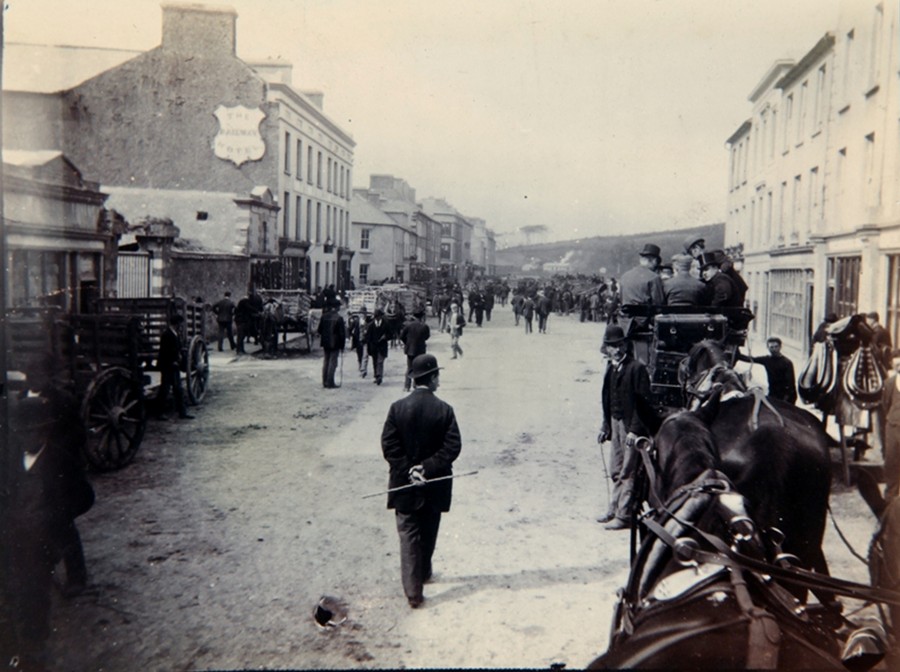
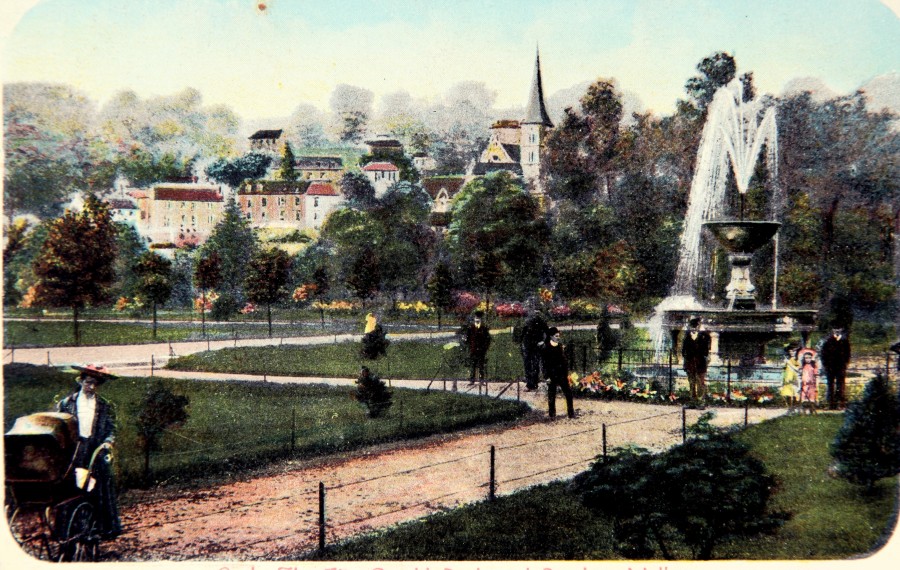
Kieran’s Our City, Our Town Article,
Cork Independent, 12 January 2017
The Wheels of 1917: Addressing a Food Crisis
The theme of the shortage of food emanates throughout the press columns of Irish newspapers in 1917. In the second week of January 1917, or one hundred years ago this week, problems of labour shortage and supply and distribution of food were the key concerns of Westminster’s Food Controller. Lord Devonport or Hudson Ewbanke Kearley was a British grocer and politician. He founded the International Tea Company’s Stores, became the first chairman of the Port of London Authority, and served as Minister of Food Control during World War I. He was appointed as Minister in December 1916 by Lloyd George and he submitted a proposal for compulsory rationing in May 1917. He developed a set of proposals designed to reduce the consumption of certain articles of food such as bread and meat.
According to the editorials of the Cork Examiner in January 1917, the price of bread was high. There was a notable disparity between the price of bread in Cork and Dublin. The high costs of freight stood out. To provide a sustainable supply, regulation was enacted to create a new “standard” bread. The bread was rolled out in Cork in the first week of January and baked in the factories of the master bakers. It was proposed at the time that the scheme would continue during the war. The price charged for this bread was to be the same as that previously in operation for beet white bread. The price was to be 11d per pair when the bread was delivered, but would be a halfpenny less per pair when purchased at the counter, and another half penny per pair less in the case of “cold” bread. Under the new rule, no “household” bread was to be on sale.
Other debates on food shortages also began on encouraging citizens to grow vegetables such as potatoes, parsnips, turnips, beans and peas and to establish allotments in the city. The growing of vegetables was not a new concept in the city’s suburban market gardens but creating labourer allotments of one eight of an acre in Cork were a relatively new concept. In early 1917, between Dublin and Belfast there were 2,000 plots in working order. In the bigger picture in Britain and Ireland, the concept of allotments and the total number of plots has varied greatly over time. In the nineteenth and early twentieth centuries, the allotment system supplied much of the fresh vegetables eaten by the poor. Westminster reports record that in 1873 there were 244,268 plots and by 1918 there were around 1,500,000 plots. To fulfil the need for land, allotment legislation was enacted. The law was first fully ordered in the Small Holdings and Allotments Act 1908, then modified by the Allotments Act 1922. Under the Acts, a local authority is required to maintain an “adequate provision” of land, usually a large allotment field which can then be subdivided into allotment gardens for individual residents at a low rent. In August 1917, the Local Government Allotments and Land Cultivation (Ireland) Act was sanctioned.
Several months before the 1917 act, the lack of real legislation governing the legalities around Ireland’s allotment scheme is evident in Cork Corporation’s initial discussion in pursuing an actual scheme. As highlighted in the Cork Examiner on 15 February, an important meeting of the city’s allotments committee was held. The Lord Mayor Cllr Thomas Butterfield presided and he gave an account of the visit of a deputation to Dublin to the Local Government Board (LGB). There they asked questions which they considered would help them in rolling out Cork City’s allotment scheme. They asked for compulsory powers to acquire land and for an independent valuer from the LGB. Compulsory powers were not granted – the same applied to other public representatives from Irish towns seeking new legal powers. The second question they asked was to be allowed to increase the grant from one-eighth to a quarter of an acre, and the Corporation to take title land for a term of years. The Cork committee made the case that a family could work an acre. This also was not granted.
At the meeting on 15 February 1917, the allotment committee proposed that Fitzgerald’s Park display an eighth of an acre demonstration plot. Councillor Sir Edward Fitzgerald was to arrange to have his gardeners look alter the plot in the park. By late February the O’Donovans of Rutland Street offered four acres on Ballinlough Road at £4 an acre purchase price. Mr Joyce gave an offer of six acres in of Mayfield at £4 an acre purchase price. Fifty acres were offered at Beaumont, the estate of Mr R Woodhead free of rent. Part of these were only subsequently utilised and control was given to the Rural District Council in this part of the city’s county suburbs.
In early March 1917 Thomas Donovan wrote to the Corporation offering 6 acres of land at Gillabbey free of charge for nine months and Frank Murphy in Shanakiel gave 2 acres free of charge. By 23 March, the committee had 229 applications with 99 in the south of the city, 52 in the north-east, 56 in the north-west, 16 in the west, and 5 in the city Centre. The key problem was that only 19 acres of land was actually secured by the Corporation and applications could not be met. The struggle to secure land continued into 1918 and 1919.
If you missed one of the columns in 2016 and before, check out the Our City, Our Town index at my website, www.corkheritage.ie
Cork 1916, A Year Examined (2016) by Kieran McCarthy & Suzanne Kirwan is now available in Cork bookshops.
Cork City History Tour (2016) by Kieran McCarthy is also available in Cork bookshops.
Captions:
877a. Fr Mathew Memorial Fountain at Fitzgerald’s Park, c.1917 (source: Cork City Through Time by Kieran McCarthy and Dan Breen)
877b. Present day pond area of Fitzgerald’s Park (picture: Kieran McCarthy)
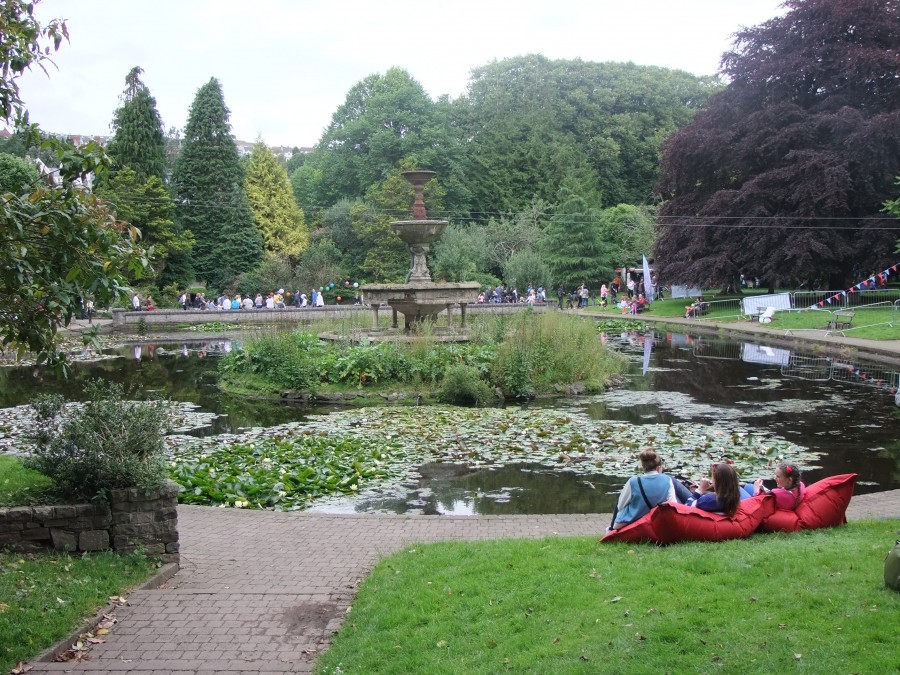
Cllr Kieran McCarthy has welcomed the recent positive response to his question of the Director of Environment and Amenity of Cork City Council i.e. that there is now a timeline to have Marina Park, the public park to circulate the new Pairc Uí Chaoimh, in place and open by the end of 2018. The demolition of the existing Showgrounds buildings is currently out to tender with responses due back on 25 January 2017. A contract will then be awarded following the completion of the tender assessment process.
Consultation with the Cork County Board design team is ongoing to ensure that the final stadium design will be seamlessly into the proposed Marina Park. The detailed design of the Marina Park will be progressed over the coming months with the tender for the construction of same issuing once the detailed design works are completed.
Commenting Cllr McCarthy noted; “these are exciting times for the Blackrock and Marina area as public amenities are cleaned up, enhanced and developed. By the end of 2018, this part of the city will have impressive public realm spaces in the shape of Blackrock Pier, Marina Park and the new stadium. It’s important now that the Council projects are kept on track and funding put aside to progress them to successful conclusions”.
To ask the CE for a progress update on the development of Marina Park ? (Cllr Kieran McCarthy)
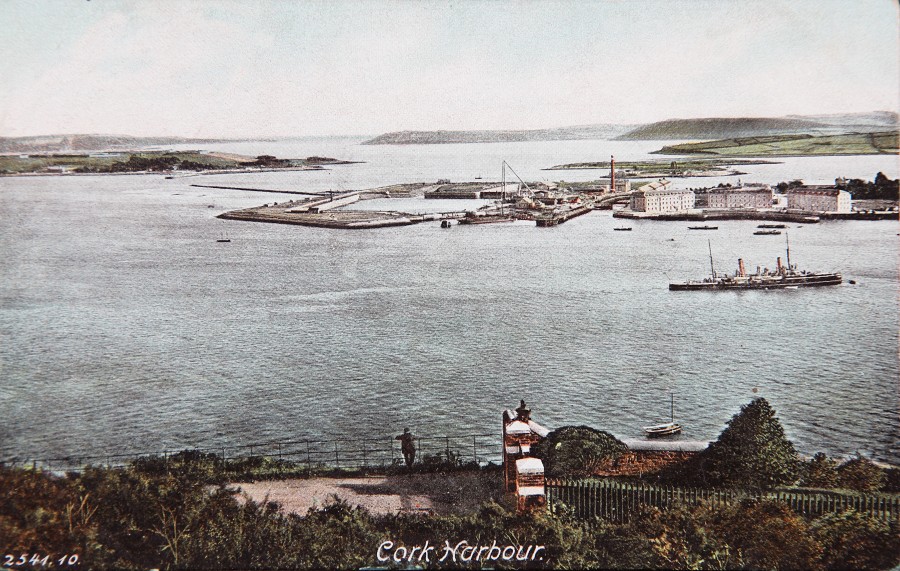
Kieran’s Our City, Our Town Article
Cork Independent, 5 January 2017
The Wheels of 1917: Setting the Scene
The 1 January 1917 began with historical echoes of the previous year. The year 1916 coincided with many great stories of a changing society in Cork from the adjustment of the clocks to Greenwich Mean Time to differing attitudes towards the Easter Rising versus those on the front lines in trenches in France to the celebration of Irish culture through the architecture of the new Honan Chapel. As the year progressed, so many different aspects of Irish culture and society came under bombardment or were progressed as outlined in the various Our City, Our Town columns last year.
I hope for the next few weeks to write about some key themes of physical, social and political developments in the city and region in 1917. A study of the daily news stories that made the headlines in local newspapers such as the Cork Examiner at first glance showcase a less eventful year than 1916. Controlled by the British government, censorship was ever present in the newspaper. However, taking many of the overarching news themes over a year, one can see key changes within society to how to best approach society issues such as war, industrialisation, the political quest for Home Rule, the role of the church, the role of violence in campaigns for a United Ireland, the impact of the re-emergence from prison of key Easter 1916 Rising key participants in late Spring 1917 such as Éamon DeValera and Countess Markievicz. The Countess herself brought a renewed call to rebellion in public meetings on the streets of Cork and Clonakilty in mid-August 1917.
The news of the first week of 1917 set the undertone for what was to come. War was ever present and by the late spring of 1917, one can feel the closeness of the front of war to Cork as more and more references are given to German submarines waiting in Irish waters to attack mercantile vessels. There are also continued references to Irish soldiers in various battalions awaiting action on the frontlines. The Reserve Camp of the 3rd Battalion Royal Munster Fusiliers in Aghada was focused upon on the 1 January 1917 in the Cork Examiner as a space of peace and quiet over the Christmas period. The Royal Munster Fusiliers raised a total of 11 battalions from the pre-war, two regular and two reserve battalions. The 3rd (Reserve) Battalion was mobilised at Tralee on 4 August 1914 and later that month deployed to Berehaven and Bantry Bay for training. In October 1914, it was moved to Cork. In May 1915, it was relocated to Aghada and Cork Harbour. Here the camp was tented and hutted in nature because nearby Fort Carlisle was full. The camp was in a field opposite the Presbyterian (former Church of Ireland) Church. The reality of the hutted camp was that it was in a poor state of repair, the training grounds confined to a few fields with no elaborate training trench system and the musketry course was thirty miles away in Youghal.
On Christmas Day 1916, Christmas Services were held in the Catholic Church and Presbyterian Church for the Battalion. The Christmas dinners in the various companies commenced at 1 o’clock, the huts where the dinners were served were decorated. The Commanding Officer, Buttevant man, Lieutenant-Colonel Richard Sherlock Brasier Creagh, visited the various companies, where he was joined by the company officers. He read the King’s message to the troops, and expressed the hope that “the men were thoroughly provided for, and that they would enjoy themselves to the fullest extent”. In addition to refreshments, tobacco, cigars and cigarettes were distributed among the men. In the evening a dance look place in the local Y.M.C.A. Hall. In October 1917, the Battalion was re-located to Ballincollig and in November 1917, the battalion was moved to England at Devonport.
A key term shining through various historical sources for the City and region in 1917 is that of Americanisation. The year 1917 was to coincide with re-election of President Woodrow Wilson and the subsequent call by the American House of Representatives and Senate to declare war on Germany. Through entering the war in April 1917 there arrived to Cork Harbour fleets of gun ships to attack the increasing attacks of German submarines, and a proliferation of American soldiers into the towns of the Harbour area and Cork City. At the end of January 1917, Germany, determined to win its war of attrition against the Allies, announced the resumption of unrestricted warfare.
Another key piece of Americanisation was the negotiations to bring a Ford tractor factory to the site of Cork’s City Park Racecourse and Deep Water Quay at the Marina. By January 1917, negotiations between representatives of the promoters and the heads and legal representatives of the local public bodies concerned, had been brought to a successful conclusion. It was announced in the press on 1 January that all preliminary details had been arranged, and that, subject to the necessary Parliamentary sanction being obtained i.e. the Cork Improvement Bill – everything would be in order and the scheme could proceed. These Parliamentary powers were to be sought for immediately but it would take until mid-July 1917 before the bill got final royal ascent after passing through Westminster and the House of Lords.
If you missed one of the columns in 2016, check out the Our City, Our Town index at my website, www.corkheritage.ie
Cork 1916, A Year Examined (2016) by Kieran McCarthy & Suzanne Kirwan is now available in Cork bookshops.
Cork City History Tour (2016) by Kieran McCarthy is also available in Cork bookshops.
Captions:
876a. Postcard of Cork Harbour, c.1910 (source: Cork Harbour Through Time by Kieran McCarthy & Dan Breen)
876b. Aghada, c.1910 (source: Cork Harbour Through Time by Kieran McCarthy & Dan Breen)
